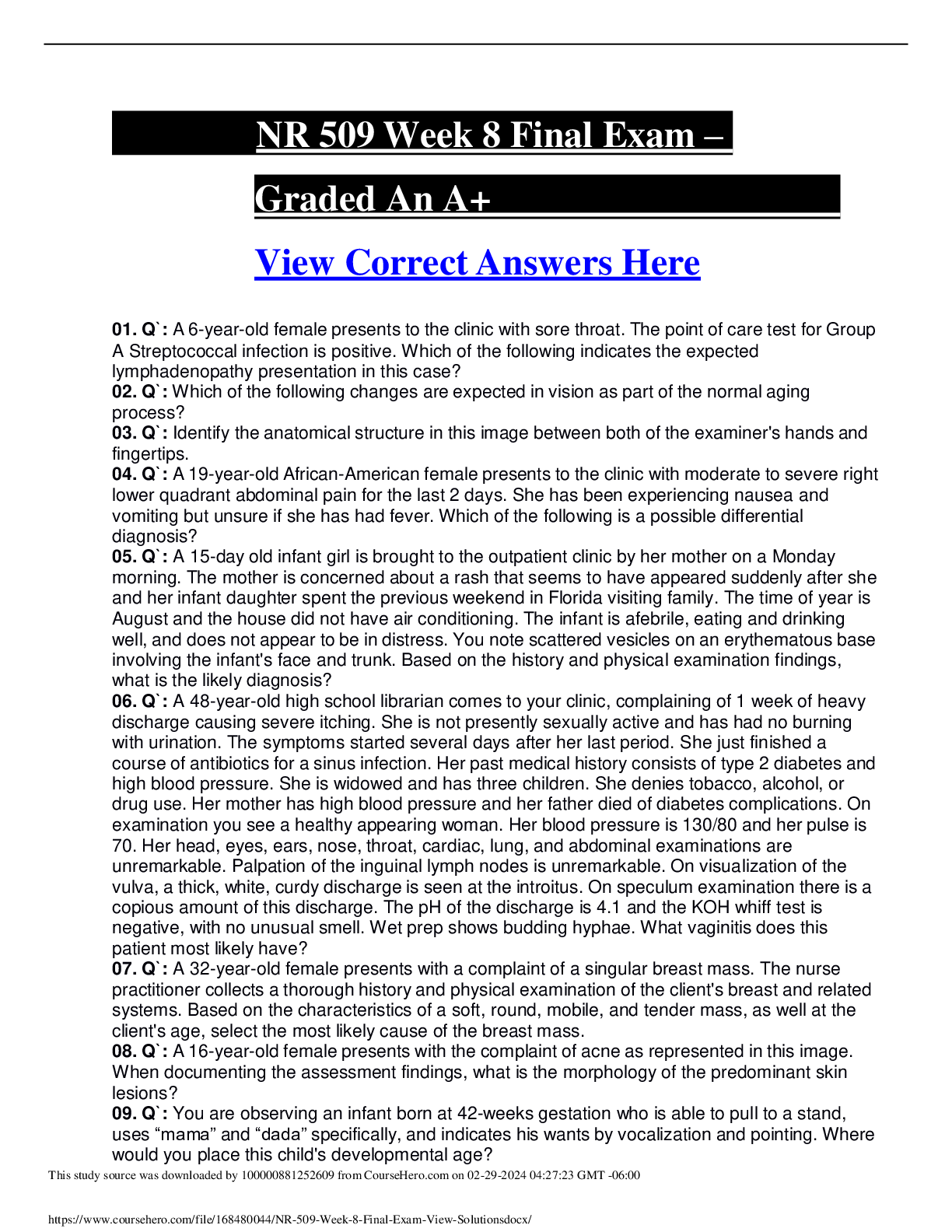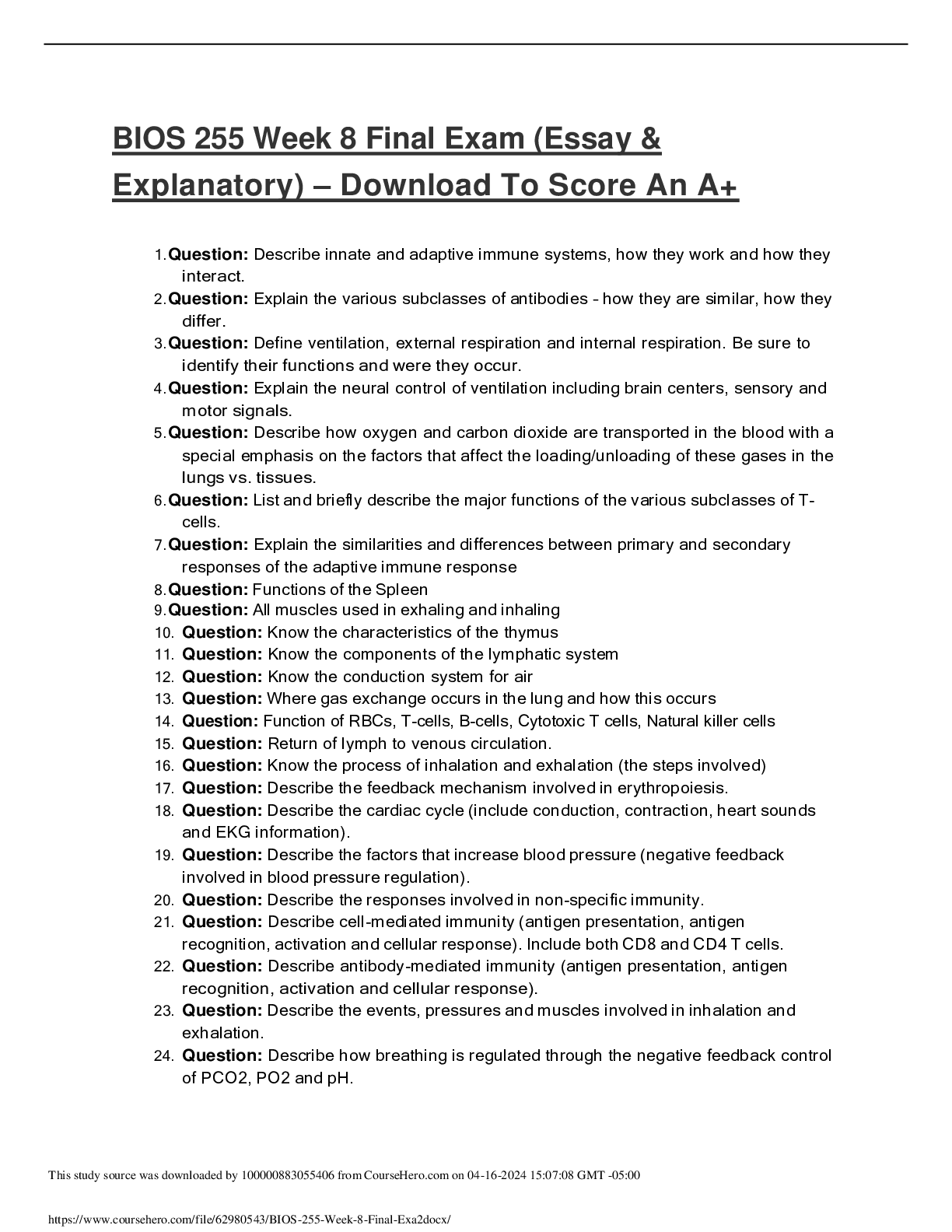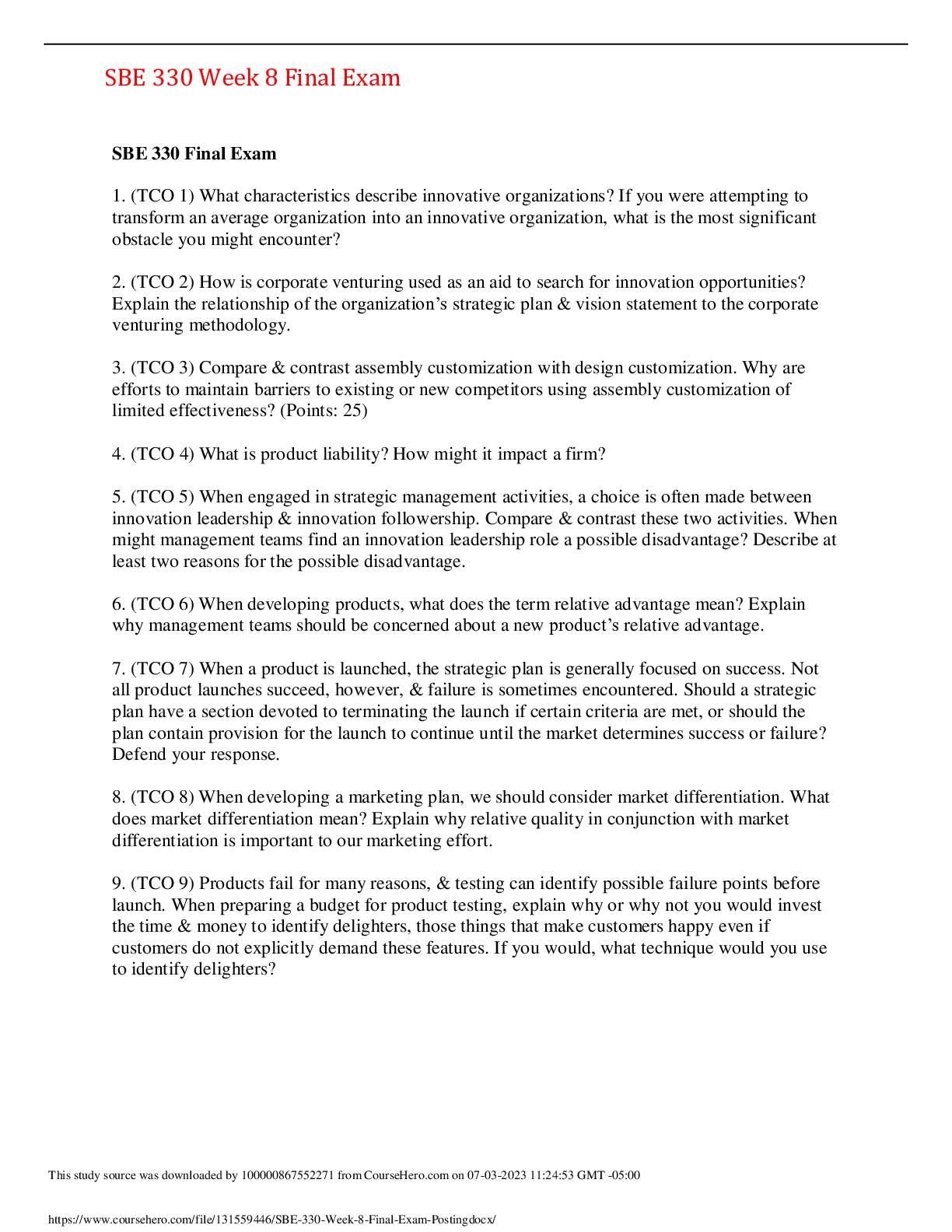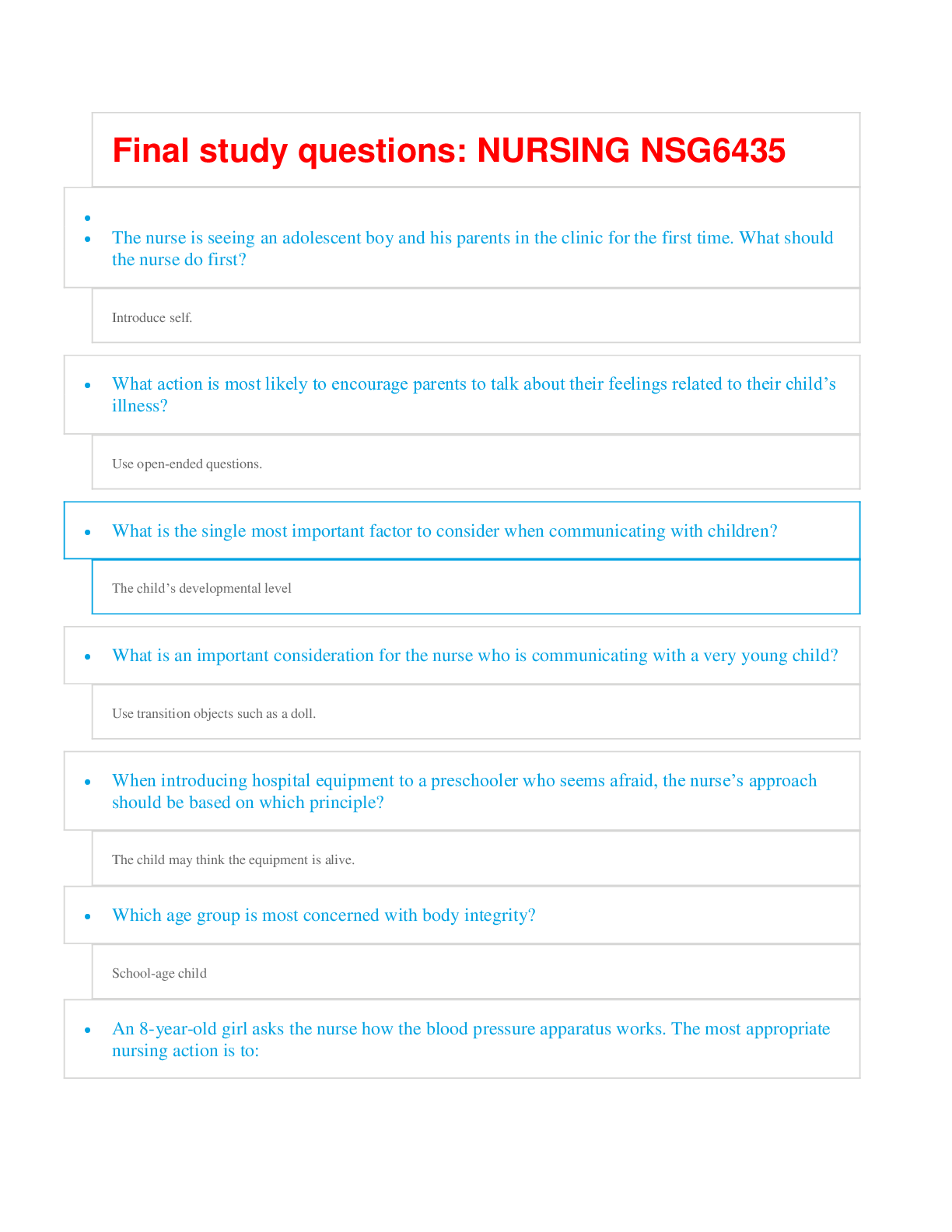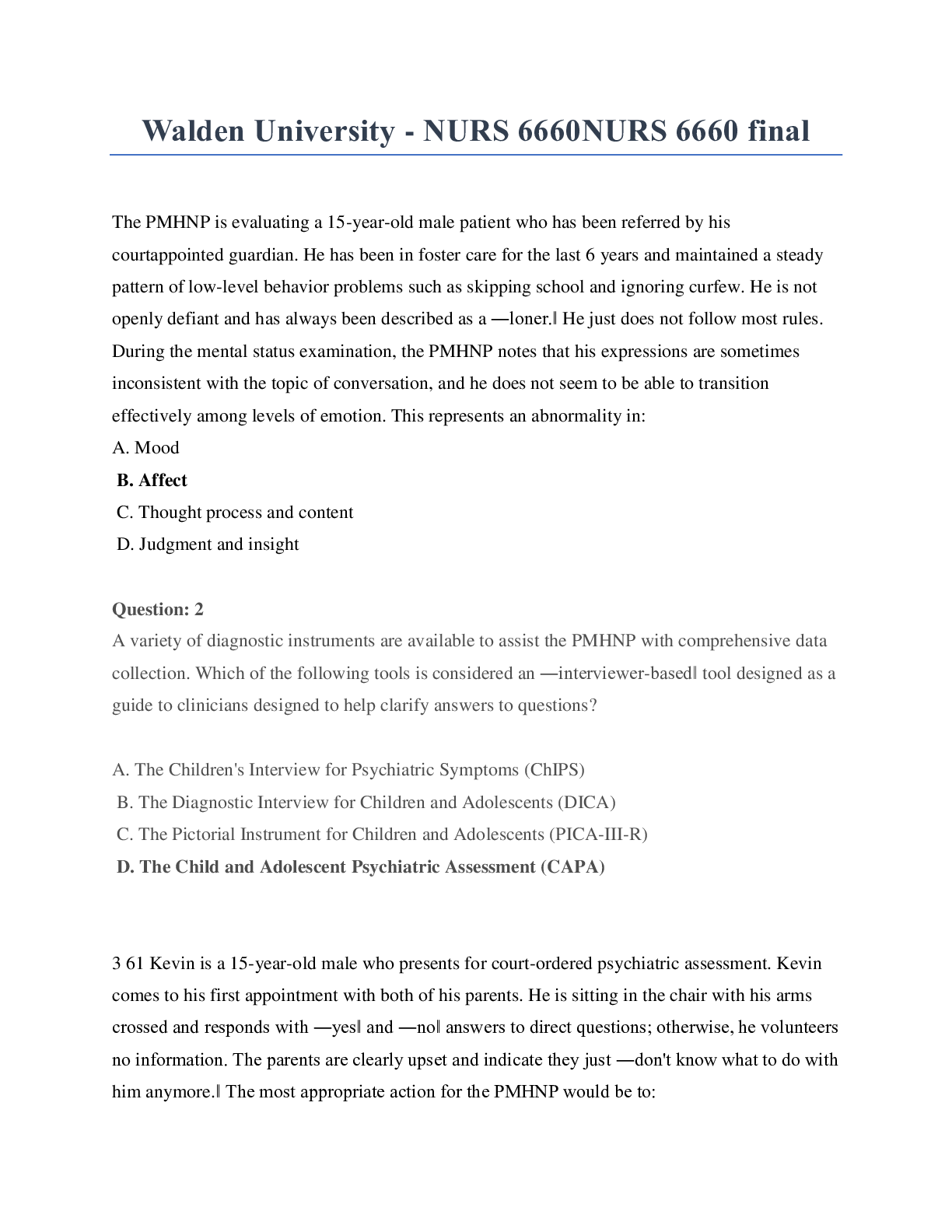Sociology > FINAL EXAM > SOCS 350 Week 8: Final Exam - Final Exam - 100% Correct Answers (All)
SOCS 350 Week 8: Final Exam - Final Exam - 100% Correct Answers
Document Content and Description Below
Week 8: Final Exam - Final Exam Page 1 Question 1.1. (TCOs 1, 2, and 8) The key to social dominance lies primarily with control over . (Points : 5) voters major social institutions th... e military universities Question 2.2. (TCOs 1, 2, and 8) Members of a society whose cultural understandings are different from one another and from the dominant culture are called . (Points : 5) an ethnic group a race White ethnics culturally different Question 3.3. (TCOs 3 and 4) A culturally distinct system of symbols, both vocal and nonvocal, that allow members of a society to communicate is a(n) . (Points : 5) language symbol argot dialect Question 4.4. (TCOs 6 and 7) For minority groups, is their experience and their identity; it has made them who they are and shaped the world in which they live. (Points : 5) discrimination history marginalization culture Question 5.5. (TCO 8) Being African American is an example of a(n) status. (Points : 5) achieved socioeconomic ascribed earned Question 6.6. (TCO 8) One's overall position in the stratification hierarchy resulting from the intersecting points of the three major dimensions of social stratification is . (Points : 5) prestige power socioeconomic status economic Question 7.7. (TCOs 4 and 7) A distinctive accent, speech pattern, terminology, inflection, argot, or slang can be triggers to ethnocentric responses. (Points : 5) voice appearance attitude behavior Question 8.8. (TCO 3) Diversity actions mandated by government regulations are collectively known as . (Points : 5) diversity training cultural awareness affirmative action reverse discrimination Question 9.9. (TCOs 1, 2, and 8) The form of discrimination resulting from long-standing behaviors and practices accepted as the normal state of affairs or a reflection of reality is called discrimination. (Points : 5) ideological or individual gender or racial egalitarian or unequal institutional or structural Question 10.10. (TCO 7) Body stance, eye contact, spatial proximity, and the like can all be triggers to ethnocentric responses. (Points : 5) voice behavior appearance attitude Question 11.11. (TCOs 1 and 2) The process of diminishing the value, importance, contributions, or attributes of a category of people is . (Points : 5) globalization prejudice discrimination marginalization ethnocentrism Question 12.12. (TCOs 1 and 2) refers to real or perceived differences among people that affect their interactions and relationships. (Points : 5) Culture Ideology Ethnocentrism Discrimination Diversity Question 13.13. (TCOs 3 and 4) The cultural pattern in which a segment of a society maintains a distinctive identity different from that of the dominant culture is . (Points : 5) ethnocentrism cultural lag cultural diffusion subculture an ethnic group Question 14.14. (TCOs 3 and 4) A negative way of thinking based on a rigid generalization about members of a particular group is . (Points : 5) discrimination prejudice ideology racism ethnocentrism Question 15.15. (TCOs 1 and 2) This occurs as a result of longstanding practices and/or behaviors that have a negative impact on members of subordinate groups. (Points : 5) Individual discrimination Institutional discrimination Ethnocentrism Marginalization Globalization Question 16.16. (TCOs 3 and 4) Which of the following statements is true about cultures over time? (Points : 5) Cultures discard some of their elements that are no longer useful. One culture enriches another culture. Cultures are more apt to grow if not isolated. All of the above Question 17.17. (TCOs 6 and 7) Why is the following statement false? You can easily figure out how to communicate with your coworkers as long as you know their ethnicity. (Points : 5) This statement assumes that all people from a culture have the same communication style and patterns. This statement does not take into account the saliency or importance of various factors on these coworkers’ communication styles. This statement does not factor in individuals’ socialization and life experiences. All of the above Question 18.18. (TCOs 6 and 7) Which of the following statements about sexual orientation is true? (Points : 5) Discrimination based on sexual orientation is illegal in over 20 states of the United States. Homosexual males have higher education levels but lower earnings than heterosexual males. Sexual minorities are comprised of lesbian, bisexual, homosexual, and transgendered people. Sexual minorities account for between 13%–15% of the U.S. population. All of the above Question 19.19. (TCO 8) High-status occupations may have plenty of , but that does not necessarily mean that they either have great power or bring economic rewards. (Points : 5) power economics socioeconomic status culture prestige Question 1.1. (TCOs 1, 2, and 8) Explain why status as a minority group is not necessarily related to numerical representation in society. Please analyze the relationship between dominant and minority group relationships. (Points : 30) Women is the first example that I think of when reading this question. Although in number, women was not the majority, women fought for the rights to vote, an won. In this case, it was not strength in numbers necessarily, but more of what was right. There were many men, such as, Henry Blackwell who co-founded the American Women Suffrage Association with his wife, Lucy Stone (www.nwhm.org). Men like Henry Blackwell and Frederick Douglas supported suffrage of women. In this situation, men are obviously the majority; however all men, did not side with the oppression of women. Around 1914, men than disagreed with equality for women, created an association in opposition (www.nebraskastudies.org). Their goal was to gain supporters to keep women from gaining the right to vote, but went a little further as they wanted to limit voting rights to those in government and those individually selected by government officials. There is strength in numbers, but the numbers do not necessarily have to be a part of the same minority group. The goal is to focus on the same mission or goal in mind and gain supporters of it. Supporters come in all genders, colors, races, and ethnicities. 2. (TCOs 3, 4, and 5) What is cultural lag? How does it relate to understandings across cultures or subcultures? (Points : 30) Cultural lag, by definition, is when material culture changes more rapidly than non-material culture (Lecture, Week 2). Knowing and understanding culture lag is important in the sense that culture is ever evolving and it tends to happen quicker from a tangible perspective. For example, many years ago, nearly twenty to be exact, I remember my parents allowing my siblings and I to go to our cousins house, they lived in an urban area, while there, we participated in things like breakdancing at the park on cardboard boxes. This would never have occurred where we lived, in a more prestigious, suburban area. Later, in the 90s, the same area where my Mom still lives, the youth is no different from any other area. The older generation has a difficult time accepting the funny colored cars with the large rims and tires but they are everywhere. Time has resulted in an incorporation of these material items across cultures and yet they seem to remain unaccepted traits. 3. (TCOs 6 and 7) Comment on how might ignorance and stereotypes of two of the following groups impact marketing efforts targeted to these chosen two populations: Hispanic/Latino, Asian Americans, Black/Africa, and Mature Americans. (Points : 30) As ethnic diversity continues to steer change in the marketing world, there are companies like McDonald's that is taking full advantage of the opportunity. Business Week (2008) published an article that identified and some of the techniques that McDonald's is using in advertising to the African- American communities. For starters, the majority of McDonald's commercials and advertising feature African-Americans. This only makes sense that they would do this as the majority of their restaurants are in urban communities; therefore, appealing to the community you serve most is a great business strategy. On the downside, African-Americans are prone to developing diseases like hypertension and diabetes which means that higher contents of fats and carbohydrates are not necessarily good for their health. When I think about the mature American, I immediately visualize the many medication commercials between watching my favorite TV shows. Most of the advertising involves medications such as bladder control, sexual dysfunction therapy, Alzheimer's treatments, and fall prevention supplies, such as bathtub replacement. Aging is inevitable and unfortunately with old age comes health problems that we never think could happen to us. All of the advertisement that I see on TV are those that I also treat many patient for while hospitalized. In both cases, both areas of advertising to the African-American community and the Mature American include stereotyping; however, it works well for these companies and their revenues generally soar. I can write with full belief that it works for McDonalds as I see almost every McDonalds in the urban communities in the tri-county are remodeling and that cost a lot. In the area of medications, I can't even say how many people I have taken care of that ask for a medication they have seen on TV. Advertising that is ignorant and stereotypical, but it works. 4. (TCOs 4 and 7) Discuss and give examples of three triggers to ethnocentric responses. (Points : 30) Ethnocentric responses to believe that superior to another or simply evaluating cultural differences in relationship to one's own cultural standards (Lecture, Week 1). Example 1: The belief that your religion is better that someone else's. This is an unfortunate situation, especially living in America where we have so much diversity. I can recall a time when my cousins had a major disagreement because one is Muslim and the other Christian. The Christian tried to downplay the Muslim religion because of the way that they eat. There are quite a few limitations as to what they can eat and my Christian cousin just did not understand. To ease the conversation, myself and other cousins tried to get each to understand that it is okay to agree to disagree. Example 2: A quite obvious example is Republicans and Democrats. Both groups have similar goals to provide change that will lead us to a better society and people as a whole. Unfortunately, each group wants to do things their way; therefore, conflict arises and the people generally suffer more times than not. Example 3: Culture and background in general is probably one of the most controversial examples of ethnocentrism and with that written, I can talk about my own parents. My mother is of Indian descent. She was sent on a vacation with her cousin to the Bahamas nearly 45 years ago. During that vacation, she met my father, whom she obviously married. My father on the other hand is Haitian and was living in the Bahamas at the time. He was a prominent business man, owner of the largest construction company on the island, but that did not matter, he was still a black man that did not share the same views and likeliness of my maternal grandparents. My mother was disowned for 17 years because she married a black man. My maternal grandparents never met my father as they refused. Sadly, when my maternal grandparents finally came around and found my family, I was a preteen and they immediately fell in love with all of us, including my Dad. 5. (TCO 8) Describe strategies that can be developed to address the issue of inequality in resources that often result in conflict between the dominant and subordinate groups.(Points : 30) Knowledge, openness, and understanding is a starting point to break the lines of inequality. Knowledge provides the educational background to learning about other cultures. Allowing oneself to be open to gaining such knowledge starts to close the gap of ignorance. Understanding is created when the knowledge is gained and the opportunity to accept others is chosen. We have to go beyond this to truly address the inequality, according to Jayati Ghosh, a writer for Poverty Matters Blog, she writes that once the discussion of these inequalities begin, the next step is to talk about policies and procedures that will ensure we remain on task. Creating policies and procedures is the best way to enforce the step-by-step activities created to meet the goals are completed. Ghosh, J. (2014). Online Publication. Retrieved from http://www.theguardian.com [Show More]
Last updated: 3 months ago
Preview 1 out of 12 pages

Reviews( 0 )
Document information
Connected school, study & course
About the document
Uploaded On
Jan 23, 2024
Number of pages
12
Written in
Additional information
This document has been written for:
Uploaded
Jan 23, 2024
Downloads
0
Views
25


